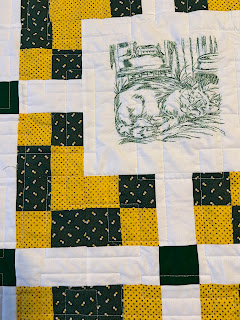The Jacket – Getting Started
To begin, I took the time to press the fabric, lining,
interfacings and pattern pieces. Over
the years, I stopped doing those initial steps – didn’t seem necessary. What I noticed was that my fabrics were
easier to handle and the salvages easier to align. The pattern pieces also laid out nicely with
no turned under edges or corners. So,
there is something to be said for 8th grade home economics sewing
lessons. Following those long-ago
lessons, I carefully measured the distance from the salvage to the straight grain
line on each pattern piece. I am pretty
good at eyeballing the straight grain but this time I didn’t want to be off
I had forgotten how nice it is to work with
good wool. It felt good to the hand and it
stays in place! I had new pins from last
year’s retreat which I had not used and decided to give them a try. For the wool, I used Taylor Seville Magic Pins quilting pins (regular 1 ¾ inch,
blue). These have a softer plastic grip
at the top which make holding the pins easier and they slide through the
pattern and fabric with ease. No,
catching, snagging, or bending! Next was
the lining fabric. It is slippery,
slippery, slippery. In order to keep the
selvage together, I used Wonder Clips to hold the edges and pattern weights to
keep the fabric on the cutting mat. The
quilting pins did not slide in so smoothly with the viscose-acetate
Jacquard lining. I also had Taylor Seville Magic
Pins patchwork extra fine (1 7/16 inch, green).
These went into the fabric with no catching or drag. My conclusion, pin size and sharpness can
make a difference in how easy or hard it is to pin. Time to throw out all those old dull pins. (Picture
of pins below.)
Finally, I cut the interfacings.
The hymo canvas was used for the main front interfacing, the underarm
interfacing and cut on the bias in 1 ½ inch strips to interface the hems. The hair canvas was used to create the three
chest pieces for each side which help fill in the arm under the shoulder. The domette is used to cover the hair canvas
(no pokes through the outer fabric) and to create a pocket for the shoulder
pad. The back interfacing is cut from
the lightweight cotton; and the undercollar from felt with linen canvas already
pad stitched to it. The felt has no
grain but the linen canvas does. It
comes applied on the bias, the undercollar straight grain line needed to follow
the straight grain of the bias piece which meant that the undercollar pattern center
back-line was position straight to the selvage edge.
I added one more interfacing – the patch pockets. I drew a new pattern piece that followed the
fold-line at the top of the pocket and the stitching lines. This piece fits inside the pocket seam
lines. I used the hymo canvas for the
pocket interfacing pieces.
The next segment will be making the pockets and placing them
on the jacket front. I will cover that
in the next post.



Comments
Post a Comment